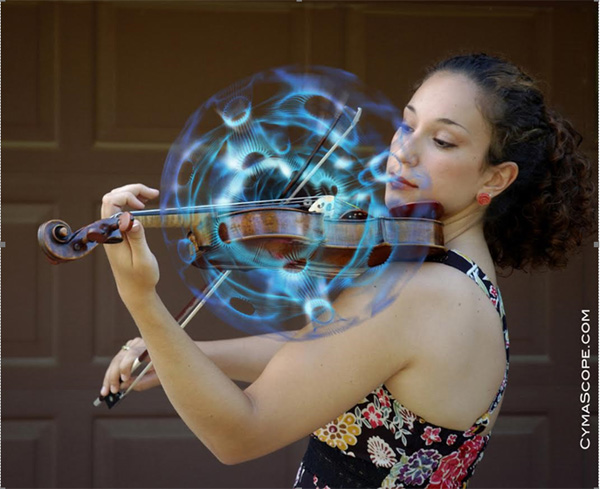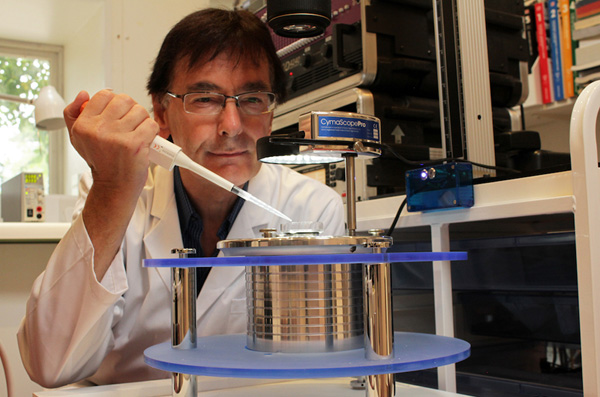|
|

|
  
Features
Update 2019/5/31
Technology
brought to you in part by

CYMATICS - THE SCIENCE OF SOUND MADE VISIBLE – OPENING NEW HORIZONS
By Suzanne Forcese
If we could see the sounds around us with the naked eye, we would see myriads of holographic bubbles each with a kaleidoscopic-like pattern on its surface. This previously hidden aspect of Nature has been revealed through Cymatics - the science of sound made visible. When the vibrations of sound are imprinted on water they are converted to water wavelets creating geometric patterns that represent a model of the sound. An instrument called the CymaScope, developed by scientist, researcher, and acoustics engineer, John Stuart Reid, allows us to image a circular section through a holographic sound bubble unveiling its unique multifaceted designs.
WaterToday had the pleasure of speaking with Reid about his invention which not only has the ability to produce remarkably beautiful art forms but also has applications in almost every branch of science. Since everything in the universe is in a state of vibration the CymaScope can provide important new scientific insights to the structures within sound and vibration.
In 1996 and 1997 Reid conducted a series of acoustic experiences in the Great Pyramid of Egypt. As only one of two people to have studied the acoustics of the King's Chamber, Reid admits he was moved to tears by the experiences in the chamber, experiences that led him to develop the CymaScope instrument. One experiment involved "stretching a PVC membrane across the open top of the 3.7 ton granite sarcophagus, exciting its quartz-rich granite with sound and then sprinkling sand on the membrane." The sand would, according to theory and similar experiments he had conducted in the lab with a wooden model of the sarcophagus, take up positions based on the resonant behavior of the material, in
this case granite, revealing acoustic aspects of the sarcophagus. "I expected to see geometric patterns but instead, amazingly, a series of ancient hieroglyphic patterns appeared. Almost every time I changed the frequency of sound a different hieroglyph appeared. I took photographs and prayed that they would develop (the days before digital cameras!) All the photos were flawless." The second astonishing result of this experiment was Reid's spontaneous relief of excruciating pain due to a severely injured lower back. These two events "inspired me to design an instrument to make sound visible and investigate how sound has the power to heal."
Reid soon realized sand's inadequacy as a revealing medium because its singular dimensionality limited the detail that could be achieved. Pure water became the revealing medium of choice. "The purer the better. When sound enters water it organizes the molecules on the surface and the sub-surface, creating highly detailed, quasi 3D images or 'CymaGlyphs' because the 'pixel' in the image is literally the size of a water molecule."

Violin Sounds Courtesy John Stuart Reid
In 2017, in collaboration with Professor Sungchul Ji of Rutgers University, Reid created the Digital CymaScope. Cymatic patterns created by sound as it imprints on the water's surface and sub-surface are captured by a high specification digital camera. The camera imagery can then be analysed by powerful software tools and applied to almost every branch of Science. The building blocks of matter, whether gas, liquid, sold or plasma, consist of vibrating atoms and or molecules and harmony exists at all levels even extending to orbital motions within the atoms and molecules. Mathematical constants of the universe, including phi, also known as the 'golden mean' can be observed in the visual geometry created by
sounds as they imprint on flexible and semi flexible surfaces. Reid hypothesizes that because the phi ratio is embedded within sounds devoid of harmonics – sounds that we label as pure -- they create what he terms "sonic scaffolding" in water, a strong candidate for triggering, organizing, and structuring life in the primordial oceans.
Reid's work has certainly attracted the best of the best in the international science community. Nobel Laureate, Professor Brian Josephson, featured the CymaScope in a lecture at the Royal Society of Medicine on the subject of memory of water and ordering processes. He stated, "Water exhibits remarkable structural and dynamic properties, including the 'biological signal' revealed by…the complex acoustically-induced structures in water...The CymaScope is not just a new scientific instrument but new science and I expect a new field of maths."
Reid's experiments with water's ability to store information were inspired by an observation. "We make people's voices visible as a means of supporting our laboratory costs. One day I noticed that a Japanese vocalist's voice took less and less time to form a CymaGlyph as he progressed through his song. Subsequently I ran a series of experiments and concluded that the water remembers frequencies for up to 30 minutes or longer."
Dr. Lila Pine, Professor at Ryerson University in Toronto stumbled across this phenomenon as well but believes water's memory may not be limited by time. WT spoke with Dr. Pine, New Media artist of Saagajiwe, FCAD's Indigenous Communication and Design Network. Dr. Pine, whose native language is l'nu (Mi'gmaq) was interested in actually "seeing" language, a new aspect of the science of phonology. She was also interested in preserving the First Nation languages. That desire took her to work with the CymaScope in Reid's lab. "At first I didn't have much confidence that my idea would work because he was so involved with dolphins and other projects but to my amazement after several different voices being tested we saw different patterns emerge from First Nation languages and Canadian English." Dr. Pine returned home armed with Reid's instructions and three CymaScopes (one to make visible low frequencies, one for medium frequencies and a third for high frequencies) because the First Nations languages she wanted to see and record have varied tones and fluctuations.
Reid had given Dr. Pine very specific instructions about the water she was to use: pure, medical grade water and a set temperature. Experiments involved having subjects speak in their First Nations language that was specific to their territory. Her first indication of water's memory occurred when in a test with one subject there had been a time lapse between voice samplings. On the second round she realized the water was holding on to the previous words. "The light bulb went on when one of my students said 'why aren't you using our mother water?' That was when I began taking water from source - from the territory where those native speakers were speaking to the water." The result was a much more beautiful and intricate visual imagery "Perhaps because the water was remembering that language."
The knowledge that water has memory certainly opens the door to many applications. Reid suggests that "If we immerse music in water, then drink the water, my research has shown that we are literally imbibing the music. A new medical system imprinting water with healing frequencies could evolve with this phenomenon". Music therapy is a clinical discipline using an emotional response, but the implications for water memory research point to music also having physiological/biological mechanisms.
In collaboration with Professor Ji of Rutgers University and researchers at Birmingham University Reid is attempting to create a system supporting surgeons in identifying the margins of a tumor when they are removing it. Since every type of cell in the body generates sound and since the cancer cell sounds are dissonant, there is great potential for this research in assisting surgeons and in developing new clinical modalities.
Important research has also been taking place in the oceans. A phenomenon was discovered while imaging dolphin echolocations representing a significant landmark both for marine biology and the CymaScope instrument. It was discovered in this Florida based experiment that dolphin echolocation sounds contain pictorial data and that such data can be rendered visible by means of the CymaScope instrument, adding further evidence to the belief held by marine biologists that dolphins see with sound. This conclusion also supports possible research with the deaf in visualizing their spoken language.
From art and music to Egyptology, physics, mathematics, biology, zoology and oceanology, the Cymascope is opening new horizons.
And what about other types of language? Would it be possible to capture sounds from the outer limits of the universe? Well actually, yes. In the field of asteroseismology, the CymaScope has made the sonic signature of stars visible for the first time. The star 'HR 3831-A' has an interesting sonic signature that was discovered by Professor Kurtz of Lancaster University. Sounds created by stars can provide important data regarding atomic processes at work in the hearts of stars.
The invention of the CymaScope instrument has taken Reid on a whirlwind journey of discovery, collaboration and international recognition but perhaps the crowning glory of his work to date is capturing cymatic patterns forming on the surface of submerged air bubbles. He hypothesizes that sound sparked life in earth's primordial oceans. It is generally believed that life began around hydrothermal vents, places on the ocean floor where warm gases escape from the earth into the water, creating a continuous stream of bubbles. It is also generally believed that the oceans were seeded with the building blocks of life - amino acids and sugars—by comets. This idea has been supported in recent years by space crafts that have landed on comets and sampled the dust, finding organic compounds. But how were living organisms structured from this 'soup' of organic compounds? Reid suggests, "If we take a Rolex watch and disassemble it, placing its hundreds of parts in a glass flask, which we then shake… how long would it take for the parts to accidentally come together in the form of a working Rolex watch? The answer is of course, never. What is needed is an organizing force. In the case of life, I propose that the organising force was sound. The sound was provided by the jostling of the bubbles streaming from the hydrothermal vent.
Each size of bubble automatically 'chooses' the frequency of sound with which it naturally resonates. The smallest bubbles would resonate with higher frequencies and the larger bubbles would resonate with lower frequencies."
In the experiment the cymatic patterns that formed on the surface of the bubbles represented the organizing force needed to arrange organic compounds. "Cymatic patterns consist of anti-nodes, places of maximal vibration, and nodes, places of minimal vibration. Naturally the organic compounds would find safe haven in the relative stillness of the nodes. This could be a first important step in answering how life began.
The CymaScope has applications in almost every branch of science simply because vibration underpins all matter. A single atom can vibrate with all the complexities that make each sound unique. Every atomic particle in a sound bubble contains all the vibrational data of the sound source. The ability to see such vibrations using water as a medium permits a depth of study previously unavailable to scientists, engineers and researchers. The Art of Science and the Science of Art.

John Stuart Reid pictured with his CymaScope Instrument -
Courtesy John Stuart Reid
suzanne.f@watertoday.ca
|
|
|
Have a question? Give us a call 613-501-0175
All rights reserved 2025 - WATERTODAY - This material may not be reproduced in whole or in part and may not be distributed,
publicly performed, proxy cached or otherwise used, except with express permission.
|
| |